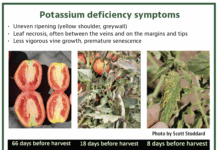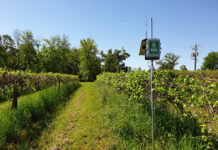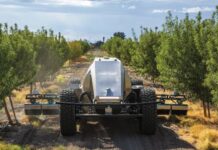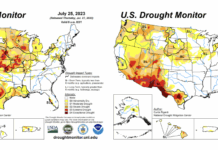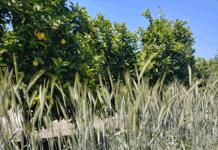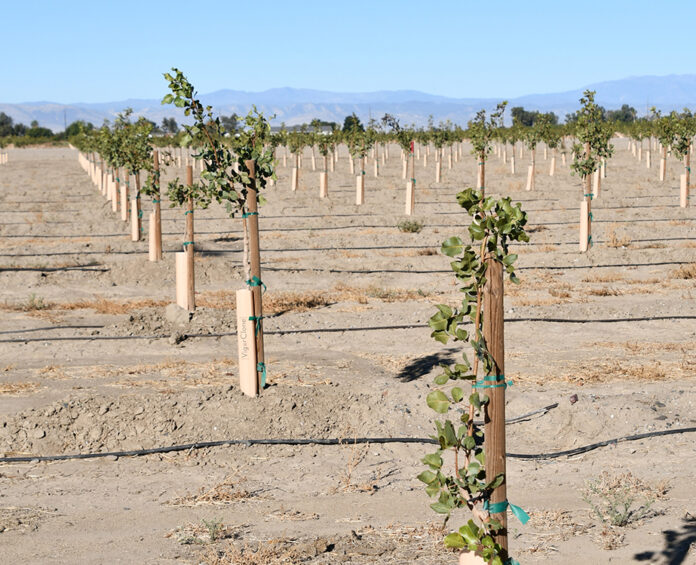
Listen to the audio version of this article (generated by A.I.)
One of the common requests I have received from growers and other agricultural stakeholders in the Sacramento Valley is for insights into alternative crop options that are drought- and disease-resistant and have the potential to command higher prices. With high production costs squeezing profits for major crops like walnuts, almonds and prunes, and yields becoming increasingly uncertain due to weather and disease, it is no surprise that growers are showing increased interest in exploring new crop enterprises they can diversify into. A crop enterprise is a farm activity focused on producing a single crop commodity, like prunes, almonds or walnuts. A grower’s overall farm business operation includes all the enterprises they manage. Helping growers choose the right crop enterprise for their farm is key to that success.
This article draws on the PRIMER method designed by professors Tim Woods and Steve Isaacs of University of Kentucky Cooperative Extension. In no order of importance, PRIMER stands for: profitability, resources, information, marketing, enthusiasm and risk. Each factor comes with guiding questions to help growers assess whether a new farm enterprise is a good fit. The full PRIMER article provides detailed worksheets and factor-specific questions to support deeper evaluation when selecting a new farm enterprise (see resources). This article highlights some of the basic, yet essential questions that are often overlooked. If a grower answers more “yes” than “no” or “maybe,” they are a good candidate to pursue options further in a detailed analysis.
Profitability
Unless the operation is intended as a hobby, assessing profitability is a necessary step before adopting any new crop enterprise. Profitability is not just about high market prices; it also depends on yield potential and production costs. For commodities like orchard crops that take over a year to generate revenue, an investment analysis may be necessary to determine if they can realistically generate enough returns to cover the expected initial and ongoing production costs. Upfront or initial investments, such as planting, land acquisition or irrigation systems, are expenses needed to get started. Measures like net present value, which considers the time value of money and the size of the stream of returns over time, can help evaluate whether the long-term returns will be worth the investment. Some high-value crops may appear attractive due to strong market prices but come with significant costs that can quickly erode margins. Market conditions may play a role. Attractive prices may draw many producers to the same crop, leading to oversupply and depressed prices. Taking a balanced approach that accounts for expected costs, yields and market conditions will help make more informed decisions.
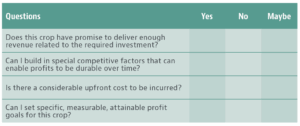
Resources
A new crop enterprise may require a different set of resources, such as land, labor, equipment and buildings. When current resources can be leveraged, the risk of entering a new venture is significantly reduced. Growers should be realistic about what they already have and what they are willing or able to invest in to avoid costly surprises. Additionally, lenders may be hesitant to provide financial support for large capital investments for untried alternatives.
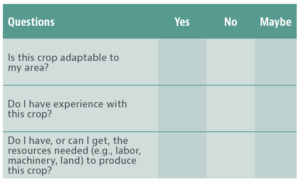
Information
Access to relevant information is essential when considering a new crop enterprise. While the internet has expanded access to agricultural knowledge, the abundance of information requires careful filtering to identify trustworthy sources and details relevant to your specific situation. Without accurate and applicable information, even the most promising crop enterprise can lead to costly missteps. Research-based insights shared through workshops, field days and newsletters from Cooperative Extension services have long been a trusted resource for helping California growers make informed decisions. Additionally, talking to other growers with firsthand experience can provide valuable real-world perspective.
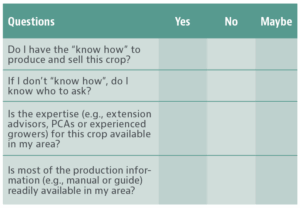
Marketing
Successfully growing a new crop is only the first step; growers also need to sell it profitably. Thus, marketing must be integrated into decision-making from the start, not addressed only after harvest.
A good marketing plan is just as important as a good production plan. Building relationships with potential buyers and understanding their preferences is critical to meeting market demands. Researching buyer preferences can help identify unique product features that enhance market appeal. Growers should also evaluate which available marketing channels, be it direct sales, contracts, wholesale, retail or cooperative marketing, best align with their business goals as prices can vary significantly across channels. For crops that must be sold to processors or handlers, growers should understand their requirements, including contract terms, and whether they are accepting new growers.

Enthusiasm
Enthusiasm can fuel the determination needed to overcome challenges, pursue new knowledge and push a new enterprise toward success. However, it is important to balance passion with objectivity. While strong emotional ties may drive commitment, they can also cloud judgment and lead to decisions that overlook practical or financial realities, even for experienced managers. That is why it is essential to clearly identify both the reasons for pursuing a new crop enterprise and the reasons for choosing not to during the evaluation stage. Pairing these reflections with a list of specific, measurable and attainable goals can help clarify your motivations and answer the key question: Why do I want to do this? That said, many growers today are asking about new crop options not out of excitement but out of necessity because current options don’t seem profitable due to high production costs and low prices. This shift in motivation is entirely understandable and important to acknowledge. Even if enthusiasm is not a main driver, taking the time to reflect on goals and expectations remains a valuable part of the grower’s decision-making process.

Risk
Agriculture involves many sources of risk and uncertainty, whether from production, markets, finances, legal or personal factors. When evaluating a new crop enterprise, it is important for growers to ask: What are the key risks involved, and how am I prepared to manage them? A sound decision-making process identifies the major risks and considers how they can be mitigated. Some examples of risk management strategies are diversification, insurance, marketing contracts and credit reserves. Keep in mind that the more unusual or unfamiliar a crop enterprise is to a grower’s region, the greater the potential risk.
Exploring new crop enterprises can be a good strategy for growers looking to adapt to rising costs, market shifts and environmental challenges. However, choosing the right enterprise involves more than identifying a high-value crop price; it requires careful evaluation of goals, resources and risk tolerance. The PRIMER method offers a practical starting point, guiding growers through key considerations: profitability, resources, information, marketing, enthusiasm and risk. Taking time to ask the right questions about these factors upfront can help growers avoid mistakes and build a stronger foundation for long-term success.

Resources
Woods, T., & Isaacs, S. PRIMER for Selecting New Enterprises for Your Farm. University of Kentucky Cooperative Extension Service. Agricultural Economics Extension No. 00-13 August 2000 Link: https://agecon.ca.uky.edu/files/ext2000-13.pdf


